|
Sembach AB
Hahn AB
Bitburg AB
Kadena AB
Osan AB
Tainan AB
Lowry AFB
Wheelus AB
Orlando AFB
Camp Happiness
Missile History I
Missile History II
Missile History III
The MM-1
Collectibles
Home Page
|
The 38th Tactical Missile Wing 18 June 1958 - 25 September 1966

USAF Outstanding Unit
Award
1 Apr 1959 to 30 Jan 1961 - 1 June 1964 to 1 June 1966 |
|
The history of the first U.S. Air Force tactical missiles in Europe began in 1954 with the arrival of a single squadron of B-61A Matadors in the Eifel Mountains of Germany with the 1st Pilotless Bomber Squadron (Light). A second squadron, the 69th Pilotless Bomber Squadron (light), arrived a year later. A third missile squadron arrived a in 1956, after the U.S. Air Force changed the name from "Pilotless Bomber" to Tactical Missile. The 11th Tactical Missile Squadron was the final unit transferred en-masse from the United States to West Germany in support of NATO.
The B-61A became the TM-61A, and was later replaced by the TM-61C. A tactical missile group was eventually formed, the 7382nd Guided Missile Group, and finally on September 15, 1956, the first tactical missile wing evolved, the 701st Tactical Missile Wing.
On 18 June 1958, the pioneering 701st TMW was inactivated and replaced by a formidable component of NATO that stood duty until 1966, using the TM-61C Matador and two different versions of the later TM-76 Mace, at eight different launch sites throughout West Germany, the 38th Tactical Missile Wing.
The 38th TMW became unique on 1 September 1959 when the wing relocated from its tenant assignment at Hahn Air Base (The host at Hahn was the 50th Tactical Fighter Wing) to its host assignment at Sembach Air Base, making it the first operational missile base in the U.S. Air Force. Undergoing changes dictated by the Air Force adoption of the "Dual Deputy" responsibility concept on 25 September 1962, the group command structure was replaced with new squadrons and redesignation of older, established units.
One component of that wing, the 71st Tactical Missile Squadron, a direct descendant of the 1st PBS, the very first operational missile squadron in the U.S. Air Force, was assigned to the 36th TFW at the inactivation of the 38th TMW in 1966 and remained on duty until April, 1969. |
This website was originally designed in 1996 to offer a photo history of the training facilities, launch pads, maintenance areas, and main bases, interspersed with comments and stories from the men who actually stood alert launch duty, worked in the maintenance shops, pulled KP, and stood guard duty with the 38th Tactical Missile Wing. As the web site grew, so did the scope and purpose of the web site itself.
The stories and photos are of not only the 38th TMW, but of all units equipped with the pioneer tactical missiles of the U.S. Air Force: The Matador and the Mace. We have added pages about Wheelus Air Base in Libya, and have a detailed two-part photo history of the 498th Tactical Missile Group at Kadena, Okinawa. Planned expansion of the Osan and Tainan pages is in the works and should be posted to the web site in early spring 2010. We welcome photos, old orders, manuals, unit histories and stories to expand our history of the pioneering units and people of the first operational missiles in the U.S. Air Force.
The web site also has a three part pictorial history of the missiles themselves, and of the famous MM-1 Teracruzer. A collectibles page is also included. Interspersed throughout the web site are stories and side bars with information and photos not found anywhere else. While not every one will want to browse the 50 pages of this web site or view all of the hundreds of photos, anyone interested in this phase of U.S. Air Force history will find a thorough and complete history of the first operational missiles in the U.S. Air Force.
While there are 50 pages of unique photos and stories on this site, you can find the full story of the development and deployment of the first U.S. Air Force tactical missiles chronicled in our book, co-authored by George Mindling and Robert Bolton, U.S. Air Force Tactical Missiles 1949-1969 The Pioneers, detailed below.
We hope you enjoy our effort at saving this fading piece of U.S. Air Force history. |
George Mindling
Port Charlotte, FL |
Robert Bolton
Lawrenceville, GA |

|
The 38th Tactical
Missile Wing was the only US Air Force missile force
left in Europe by the
Cuban Missile crisis resolution.
All IRBM and other U.S. Air Force missile units in Europe were removed. |
-
Ref: National Security Archives
-
Ref: The Other Missiles of October: Eisenhower, Kennedy, and the Jupiters, 1957-1963
by Philip Nash, University of North Carolina Press, 1997 (see Operation POT PIE)
-
Ref:
Message From the Soviet Ministry of Foreign Affairs to the Soviet Ambassador to the United States (Dobrynin)
U.S. Department of State Electronic Archives Jupiter Missiles In Italy and Turkey are first mentioned in Item 66
|
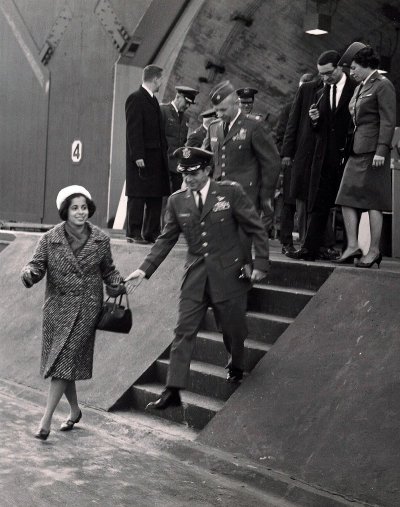
United States Ambassador to Luxembourg, Patricia Roberts Harris, visits 38th TMW Launch Site 8 at Idenheim, Germany, 1966
36th TFW photo courtesy of Wayne Douglas, 71st TMS, (lwd2856@aol.com) |
| |



38th Tactical Missile Wing - USAF |
|
The 38th Tactical Missile Wing, activated at Hahn Air Base, Germany, 18 June 1958,
was composed of three Tactical Missile groups, the 585th Tactical Missile Group at Bitburg AB, the 586th Tactical Missile Group at Hahn AB, and the 587th Tactical Missile Group at Sembach AB, in addition to a headquarters unit.
The 38th TMW assumed it's new headquarters at Sembach Air Base, Germany, on 20 August 1959, including all supporting squadrons, including the 38th TMW Hospital, becoming the first operational missile base in the US Air Force.
The Tactical Missile Groups were inactivated 25 Sep 1962 and the 38th TMW assumed direct control of the remaining squadrons. The 38th TMW was composed of launch and maintenance squadrons at detached and remote installations at Sembach, Hahn, and Bitburg Air Bases in Germany, in addition to being the host wing at Sembach.
The 38th Tactical Missile Wing had the distinction of maintaining two separate weapons systems twice, first by bringing the TM-76 Mace "A" operational in August, 1959, while maintaining the TM-61C Matador combat ready until September of 1962. The Mace"A" later re-numbered to MGM-13A, remained operational until 1966, concurrently with the Hard Site TM-76 Mace "B", brought operational in June, 1964 at Bitburg with the 71st TMS. The 71st TMS remained in service with the 36th Tactical Fighter Wing until April, 1969 with the renumbered CGM-13B (TM-76B).
|

|
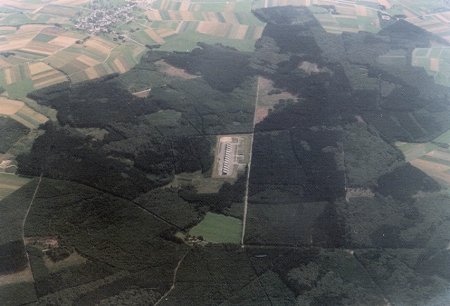 The abandoned Mace "A-Bird" Site 4 launch complex in the Hünsruck mountains of Germany from 25,000 feet, photo taken in 1974. The abandoned Mace "A-Bird" Site 4 launch complex in the Hünsruck mountains of Germany from 25,000 feet, photo taken in 1974.
Photo by Bob Bolton (olliesnapper@gmail.com)
|
 U.S. Air Force Tactical Missiles
1949-1969 The Pioneers By the Editors of this Website!
|
Beyond the Web Page... The only book devoted exclusively to the Matador and Mace Tactical Missiles. The book reveals the story from the initial idea that became the first U.S. pilotless bomber, through the politically troubled development of the ever evolving deployment methods of the Matador and Mace Tactical Missiles. It covers the Units, Groups, Squadrons and Wing that fielded the missiles. From the United States test sites, Europe, Asia and North Africa nothing is omitted. All phases of the application of these two missiles by the U.S. Air Force (and West German Luftwaffe) are included, from the first tentative launches of the XSSM-A-1 Matador in January 1949, to the tense alert duty of the Cuban Missile Crisis, and the final launch of a MQM13A in May of 1977. The maintenance, logistics and launch, the men, equipment and tactics are all there. |
|
"Bob, George, I finished your book 2 days after I received it. Couldn't put it down. It was incredible reading and incredibly detailed information."
Kent Washburn (KWASH55@aol.com) Mace B, Kadena, Okinawa
"George and Bob. I want you both to know how much I enjoyed reading and how much I admire and appreciate what you have accomplished in developing and publishing "The Pioneers". It is truly an outstanding piece of work, reflecting the time and effort required to produce it, but is also a formidable contribution to our military history. I mentioned in some earlier correspondence that I was a little disappointed in the relatively small amount of information regarding the Operating Location/Guidance Sites but you largely made up for it with this magnificent book."
Dale Lake (daleflake@yahoo.com) 601st Tactical Control Squadron, 38th TMW, Hamm, Germany
"I just finished your book, The Pioneers, et al. Please accept my "job well done!" Not only is it informative, but it's very readable. I'd also like to complement you on how well you footnoted it. You have shown that a scholarly work can be both instructive and enjoyable."
Michael Roof (lavinaschnur@hotmail.com) SGM USA (Ret.)
|
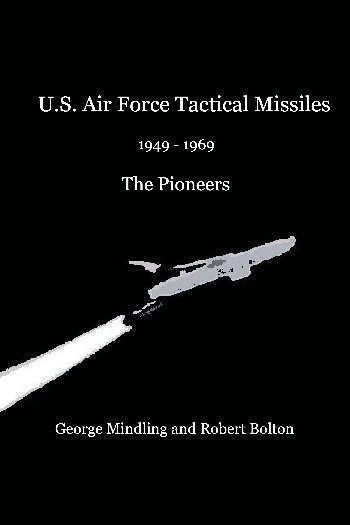
"Very good work with great detail."
Col. Charlie Simpson, USAF, Retired
Executive Director
Association of Air Force Missileers
"I have your excellent book on USAF tactical missiles. I actually witnessed the decommissioning of the Maces at Wüscheim back in 1966."
Paul Offen
Talitha, Tye Common Road
Billericay
Essex CM12 9PX
UK
|
"I just wanted to drop you a line and tell you how much I enjoyed the book that you and Bob wrote. The history was of particluar interest to me and my brother who was a history Professor at the University of Wisconsin. He also thought the book was well written, and he now knows what his little brother, (me), did while in Germany for three years."
George Joseph Snyder (gjsnyder@sbcglobal.net)
71st TMS, Steinborn, Germany
"...by the way, I read your book, it was great, thanks for writing it."
Hack Hunton (hack@sstelco.com) Mace B, Kadena, Okinawa
"George, the book arrived on Tuesday while I was off to France. Of course, I quickly read the chapter about Germany's quiet step into the realm of nuclear armament. You know, this is still a widely ignored fact over here...
...For me it is fascinating to see what the picture really was in the 1950s and 1960s as opposed to what the official communication of the time wanted people to believe. A fascinating book shedding some light on the early days of tactical nuclear missiles as well as the political background that even today is still largely hidden behind the propaganda of the time. Can't wait to read the rest of it."
Burkhard Domke
Harsefeld, Germany
|
"U.S. Air Force Tactical Missiles" is an excellent, comprehensive history of a very little-known aspect of the development and operational deployment of American guided missiles in the early days of the Cold War. The title may lead one to believe that the book is a fairly broad outline of tactical missiles developed during that period. But it really covers just one system--the Glenn L. Martin Company's TM-61 "Matador" turbojet-powered cruise missile and its follow-on, the upgraded TM-76 "Mace."
"The level of detail in "U.S. Air Force Tactical Missiles" is remarkable. The authors start out with an assessment of the world's first practical, mass-produced cruise missile--the German V-1 ("Vergeltungswaffe Eins," or "Vengeance Weapon 1") "flying bomb" that Hitler used against England and other European targets in World War II. I thought I knew a lot about the V-1, but I learned things I never knew when I read this book. Some of the technical details about its design, construction and method of operation have never, to my knowledge, appeared in print before, at least not in readily accessible form. The authors apply the same level of detail to the story of the design, development, flight testing and overseas deployment of the "Matador" and "Mace," which trace their lineage directly back to the V-1. Much of "U.S. Air Force Tactical Missiles" is based on reminiscences of former "missileers" with first-hand experience in the care and feeding of "Matadors" and "Maces" in the field. As such, it has the flavor of an "oral history" in which people and their experiences play at least as important a role as the technology."
"Very little has been written about America's early cruise missiles. As far as I know, "U.S. Air Force Tactical Missiles" is the only available book-length treatment of this relatively obscure subject. An interesting, in-depth and readable volume, "U.S. Air Force Tactical Missiles" deserves a place on the bookshelf of every serious aerospace history buff."
Terry Sunday (sundayt@zianet.com)
|
|
Inspired by the 38th TMW Website, George Mindling and Robert Bolton co-authored US Air Force Tactical Missiles 1949 - 1969: The Pioneers © 2008, the story of America's first operational missiles, from the Matador to the Mace, from Taiwan, Korea, and Okinawa to Germany, including Lowry, Orlando, Holloman, Santa Rosa Island at Eglin, and even Camp Happiness! |
|
Dieses Buch ist ein Muss für alle, die im Rahmen ihres Dienstes bei der U.S. Air Force mit den frühen Marschflugkörpern
zu tun hatten, aber auch für deutsche Militärarchäologen, die in der Eifel, im Hunsrück oder im Pfälzer Wald schon
über rätselhafte Hinterlassenschaften gestolpert sind. Nach mehr als 40 Jahren wird endlich eine Fälle von Fakten,
Informationen und Geschichten zu den zwischen 1954 und 1969 in Deutschland stationierten, mit Automwaffen ausgerüsteten
amerikanischen Matador und Mace auf den Tisch gelegt.
Ausfährlich und lebendig erzählen George Mindling und Bob Bolton von den jungen Missilemen, die im März 1954 erstmals in Bitburg ankamen -
noch ganz grün im Gesicht, weil auf dem Atlantik schwerer Sturm geherrscht hatte. Von den T-33-Flugzeugen, die aus übungsgründen so taten, als
wären sie Matador-Flugkörper, äber die Startstellungen hinweg in Richtung deutsch-deutsche Grenze donnerten und sich von der Gegenseite
nur nicht erwischen lassen durften. Oder von der Kuba-Krise, als die US Air Force Europe auf DEFCON 3 ging und an die Mechaniker in
Bitburg Munition für ihre Karabiner ausgegeben wurde.
Augenzeugen sagen dazu: "Wir hätten die Vögel auf jeden Fall innerhalb von 15 Minuten in der Luft
haben müssen!" Es ist lebendige Militärgeschichte, die nun nicht der Vergessenheit anheimfällt, sondern
jedermann zugänglich wird - auch für die ortsansässige Bevökerung, die heute endlich erführt, was sich damals
in ihrer Nachbarschaft zugetragen hat. Den beiden Autoren gebührt der Dank.
Klaus Stark (klaus_stark@t-online.de)
Berlin, Germany
This book is not only a must for all those who served in the U.S. Air Force with the early cruise missiles, but also for German military archeologists who have been puzzling over relics stumbled across in the Eifel, the Hunsrück and the Palatinate Forests. After more than 40 years, we finally have a wealth of facts, information and stories, from 1954 to 1969, of the nuclear equipped American Matador and Mace missiles stationed in Germany placed on the table.
With detailed and vivid descriptions, George Mindling and Bob Bolton talk about the young Missilemen who arrived for the first time in March, 1954, in Bitburg - still green in the face, having prevailed the Atlantic crossing in major storm. Of the T-33 aircraft which practiced as if they Matador missiles launched in the direction of German-German border, or from the Cuban missile crisis, when the U.S. Air Force Europe went on DEFCON 3 and was issued ammunition to the mechanics in Bitburg for their rifles. Eyewitnesses say: "We would have to have the birds in the air in any event within 15 minutes!"
It is vital military history that is prey to oblivion, but is now accessible to everyone - even for the local population, which today finally learns what happened at that time in their neighborhood.
The two authors deserve thanks for saving the history.
Klaus Stark,
klaus_stark@t-online.de
Berlin, Germany
|


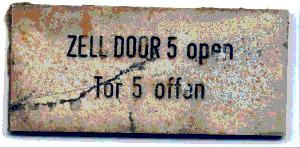 |
|
All metal launch site identification tags at Rittersdorf and Idenheim were written in both English and German in anticipation of the German Air Force assuming command and control of the four planned hardened launch sites at Bitburg.
The planned conversion from USAF operation of the Mace "B" to the German Bundeswehr (Luftwaffe) was canceled by Secretary of Defense Robert S. MacNamara in 1961. While Site 7 (Rittersdorf) and Site 8 (Idenheim) both became operational with two, four bay launch complexes each, Construction of Sites 9 (Newel) and 10 (Heidweiler) was cancelled.
Metal launch bay sign from Site 8, Idenheim, courtesy of Bernhard Gross (bernhardgross@t-online.de)
|

|
I am currently the historian at the 18th Wing, Kadena AB, and am researching the history of the 498 TMG from 1961 to 1969. I have the 313th Air Division histories, as well as the 498th histories for the whole time, but I would like to get some input from the people who served in the unit at that time. I am looking for any personal anecdotes; things that stand out as highlights/low points of the tour; specific information about the unit. I am working on a monograph for the Air Force History and Museum Program, should be ready by next year. Would love to hear from any old members of the 498th.
Thanks
MSgt Joe Orr (Joe.Orr@kadena.af.mil)
18th Wing Historian |
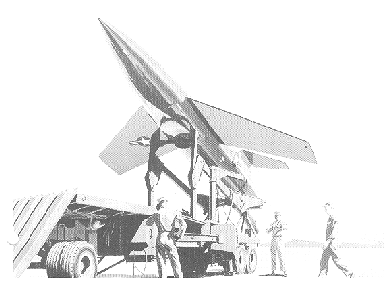
|

|
Just wanted to say the sight is fantastic! One thing that I've noticed, is
the almost total lack of information concerning Lowry AFB and the
individuals who spent their time there training the future technicians and
mechanics. I was one of the lucky ones to spend 7 years, 11 months at
Lowry, the last 6 years as an instructor for the Mace 'B' GEMS school. I
always wished I could have been in an operational unit, but the AF needs
said I was an instructor. Over the period at LAFB I was assigned to the
3419th, 3424th, and the 3421st. I always wore my pocket rocket with pride,
and the instructor badge with the same pride. Keep up the good work!
Robert D. Smith, A1C (smtrds59@att.net)
|
Great Idea! See the pages at

Welcome to our extensive, forty page web site made possible by the following people:
The 38TMW Web Pages are Possible Only Through
The Photographic and Historical Contributions of the Following People:
|
- Bob Bolton (olliesnapper@gmail.com)
- Paul Holmberg
- Ron "Ski" Wiatrowski
- Dave Johnston, SMSGT USAF (Ret) (fordman1@pa.net)
- Charles Martin
- Dave Maas (DrMaas@aol.com)
- Fred Horky, LtCol USAF (Ret)(redvette4@cox.net)
- Larry Emerson (lemerson@swbell.net)
- Gill Goering, Col USAF (ret.) (GillG@aol.com)
- Ed Cole (LMCENC@aol.com)
- Fred W. Vetter, Brig Gen, USAF (ret.)
- Glen Curl (gcurl@bv.net)
- CW Lewis
- G. Joseph Snyder (gjsnyder@sbcglobal.net)
- Tim Lewinsky (timlew@chartermi.net)
- Dennis Cralley, Sr.(dcralleysr@cox.net)
- Les Smith (LTSmith39@aol.com)
- Art Arrowsmith (arthura@macconnect.com)
- Eric Zeppenfeld (info@bfw-vanhoffs.de)
- Bud Bench (budbench@hotmail.com) USAF Retired
- Thomas Seelig (tomseelig@embarqmail.com)
- Alan Mede (almede@verizon.net)
- Bob Bailey
- Michael Wylzcynski (mjwilczynski@wideopenwest.com)
- Bernhard H. Gross (510096399026-0001@T-Online.de)
- Tobias Geiss (vladdes@freenet.de)
- Dave Bass (tncbass@yahoo.com)
- Bob Lippincott (boblippincott@aol.com)
- Lee Garwig (leegarwig@verizon.net
- John W. Harris (jwharris@cox.net)
- William Shackelford (wasbet@juno.com)
- David Behre (Davidbehre@aol.com)
- Blake Sutton (MCboatsX10@aol.com)
- Jim Hawkins (jayjhawk@swbell.net)
- Len Calkins (lcalkins002@cfl.rr.com)
- Bob Sosenko (rsosenk1@twcny.rr.com)
- Dennis Fitzsimmons (dennis@iris-inc.com)
- Wayne Douglas (lwd2856@aol.com)
|
- George Kovach (gfkgdk@aol.com)
- Paul Yadon
- Roy Mathis (ingroy@aol.com)
- Tom Walker (tr@WarBirdBob.com)
- Scott Murdock (scott123murdock@yahoo.com)
- Richard Weigert (rweigert@plastekgroup.com)
- Max Quitiquit (max.quitiquit@usaf.org)
- Thomas Seelig (tomseelig@embarqmail.com)
- Roland Fogt (Rf2401@aol.com)
- Rolf D. Görigk (goerigk@onlinehome.de)
- Kathy Geary (k.geary@worldnet.att.net)
- Charles Headlee (headlee@abcs.com)
- Ted Jarvi (TCJarvi@aol.com)
- Martyn Tagg (Martyn.Tagg@wpafb.af.mil)
- Phillip Thomas (pthomas214@cfl.rr.com)
- Robert Bimbi (rbim@peoplepc.com)
- John W. Cook SMSgt, USAF, (Ret) (Cookieman1@cox.net)
- Bill Baney, Decatur, IL. (BANEYWM@msn.com)
- Frank Roales (flroales@avenuebroadband.com)
- Garld and Janice Edwards
- Henk Scharringa (henk.scharringa@gmail.com)
- Renaud Mangallon (renax@club-internet.fr)
- Gerhard Moroff (moroff@ba-mannheim.de)
- Eric Zeppenfeld (info@bfw-vanhoffs.de)
- John Bordne (jcbordne@hotmail.com)
- Richard Boverie, Maj General, USAF (ret)
- Bill Hughes, Maj, USAF (Ret) (goldwing34@bellsouth.net)
- Barney Lambert (barney@frogdiver.com)
- Burkhard Domke (burkhard@b-domke.de)
- Bernie Ganshert, MSgt, USAF (Ret) (ganshertbm@gpcom.net)
- Ken Lasher (Kenlasher@cox.net)
- Ira "Denny" Young (ira@irayoung.com)
- W.T. de Graaf (graaf357@home.nl)
- John Gibbs (jgibbs16@tampabay.rr.com)
- George Craig (george8898@hotmail.com)
- Donald Rhodd (drhoddsr@comcast.net)
- Randy Mitchell (randymitch66@hotmail.com)
- Jim Larimer (jalarimer@gmail.com)
|
|
Special Thanks to Scott Barnes for the custom designed U.S. Flag background
Special Thanks to Martyn Tagg
HQ AFMC/CEVQ
Cultural Resources Manager
Wright-Patterson AFB, OH
for his invaluable Historical
contributions
to the History of the Matador and Mace History pages
(Martyn.Tagg@wpafb.af.mil)
My Deepest Thanks to Bob Bolton (olliesnapper@gmail.com) for his ongoing contributions and editorial comments.
The site would not be complete without his efforts.
All Intellectual and Photographic Contributions remain the property of the original owners
All Contributions used with Permission
Our Sincere Thanks to All Contributors
George Mindling
|

TAC Missileers Convention
in New Orleans, LA, in 2017!

|
People always pointed at
your chest and asked, "what's that?"
At first, you'd proudly
say "That's my missile badge!"
Then they would say,
"No, those things in the plastic container on your lapel!"

Missileers know! |

|
A series of two minute Air Force Promotional films was distributed freely to every television station in the country in the early 1960's. Among the Lowell Thomas narrated shorts is one that features the MM-1 and the TM-76 Mace. The video (Stock#:AFF226) can be can be found at Footage Bakery. The Mace and the MM-1 clip are the last item on the page. |

|
This page is in no way sponsored or endorsed by the United States Air Force.
Opinions and views expressed are those of the author and not necessarily those of the
Department of the Air Force.
|
Web Page Design and Development by
George Mindling - Port Charlotte, Florida
© George Mindling - 2003-2006, 2018, 2021 - All Rights Reserved
|

